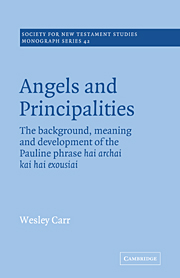 Angels and Principalities
Angels and Principalities Book contents
- Frontmatter
- Contents
- Preface
- Abbreviations
- General Introduction
- PART 1 The Background to Paul's Thought on the Powers
- PART 2 Exegesis of Pauline Texts
- 3 The powers and Christ triumphant
- 4 The powers and the spiritual world
- 5 The powers and the political world
- Conclusion to Part 2
- PART 3 The post-Pauline development
- PART 4 Final Remarks
- Notes
- Select Bibliography
- Index
- Frontmatter
- Contents
- Preface
- Abbreviations
- General Introduction
- PART 1 The Background to Paul's Thought on the Powers
- PART 2 Exegesis of Pauline Texts
- 3 The powers and Christ triumphant
- 4 The powers and the spiritual world
- 5 The powers and the political world
- Conclusion to Part 2
- PART 3 The post-Pauline development
- PART 4 Final Remarks
- Notes
- Select Bibliography
- Index
Summary
The aim of this section of NT exegesis has been to investigate the use of the language of the powers as it occurs in the Pauline literature. Because the interpretation of these powers that is here offered runs counter to much that has been written and assumed about them, the attempt has been made also to show in each case that the fundamental understanding by Paul of αἱ ἀρχαἱ καἱ αἱ ἐξονσἰαι in bonam partem is consistent with a realistic understanding of the particular errors and teaching in each letter. At this point we may enumerate the conclusions.
The use by Paul of the language of the powers and associated terms conforms to basic Jewish usage. The understanding of the spiritual world generally at this time produced multiplication of spiritual beings in relation to God, while evil was limited to one being, the Devil, together with some demons. The terms used for the powers, however, are not applied to the demons, and what language there is of demons in Paul is very scarce and conforms to the traditional Jewish association of them with idols. These terms from Paul's Jewish background would also have conveyed to Gentiles notions of power and authority that are associated not with hostile forces but with God. For in general the pagan use of these terms is for the authority and power of rulers in the secular world. The exact historical situation of Paul needs to be appreciated before any attempt is made to understand the meaning of his teaching on this subject.
- Type
- Chapter
- Information
- Angels and PrincipalitiesThe Background, Meaning and Development of the Pauline Phrase hai archai kai hai exousiai, pp. 122 - 124Publisher: Cambridge University PressPrint publication year: 1981
